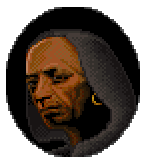Karnax
| Karnax | |||||
 Karnax, from Ultima VII Part Two | |||||
| Species: | human | ||||
| Profession: | Xenkan Monk | ||||
| Appearances | |||||
| |||||
Karnax is a Xenkan Monk living on Monk Isle. He appears in Ultima VII Part Two.
Description[edit]
While technically holding no rank amongst the Xenkan brotherhood, Karnax had come to hold a position of social seniority within the brethren of the island, despite the egalitarian nature of the order. His conservative views regarding the prophecies of Xenka brought him into conflict with the young Thoxa, who felt that direct intervention into the affairs surrounding the coming Imbalance were necessary. Using his respected position within the monastery he contrived to have her held captive, that she might not interfere with the unfolding apocalypse and thereby risk helping it come to fruition.[1]
Unfortunately for Karnax, Thoxa escaped him, embarking on a journey around the Serpent Isle as she tried to gather knowledge which might someday benefit the prophesied "Hero from Another World." Karnax followed and eventually caught the young monk, just as she was bequeathing the Hourglass of Fate on the appointed savior. Fearing that her assistance to the hero would cost the world dearly, Karnax drew his fellow into a magical duel. Eventually, however, defeated by Thoxa's unexpected prowess, Karnax vanished, barking warnings that the newly arrived Avatar's friends would bring naught but disaster.
Later on, when the hero had cause to visit the Xenkan monastery, Karnax's demeanor would prove far more amicable, with Thoxa having rejoined her fellows with little concern. Speaking at greater length to the Avatar, Karnax would reveal the passages of the Xenkan prophecies which had guided his actions, explaining that it had been forseen that those seeking the aid the promised hero would bring about their downfall. Once reconciled, the old monk would do his best to give explanations to the foreign hero about the impending events. The old man spoke with resignation of the vagueness of Xenka's visions and of the senseless death of the Ophidian civilization.
Once Miggim located the Amulet of Balance amongst the monk's holdings, it was Karnax who gave the artifact to the Avatar – handing it off even amidst the bustle of the hero's resurrection, if necessary. This talisman proved an object of fascinating capacities, moving its wearer through time itself to the twilight of the Ophidian wars, where the Avatar, now taking on the appellation of Champion of Balance, managed to obtain a still viable Silver Seed. Karnax, using Xenkan methodology to reach into the limitless powers of the Void, managed to shift himself backwards through the centuries as well, instructing the hero in the planting of the Tree of Balance.
Once the Banes of Chaos were unleashed upon the world, it was Karnax who told the Avatar to consult with Fedabiblio of Moonshade, that the hero might learn of how to stop the ravaging eidolons, and was later able to interpret the document penned by Ssithnos, which explained the particulars of the Imbalance's cosmology. It was from such studies that the monk eventually helped the hero to cure Gwenno of her insanity, and thereafter their possessed companions.
Lore[edit]
| “ | Karnax, a fellow monk, heard of my plans and chastised me for meddling with the prophecies. He told me that would bring doom down on the very land I am trying to save. While there are none on this island who officially wear the title of "leader," I fear that Karnax has taken this role upon himself. After several confrontations with him, I decided I could no longer stay on Monk Isle, so I set out upon the journey that I will chronicle in these writings. – from Balancing the Scales (Ultima VII Part Two)
|
|---|
Trivia[edit]
- Should the player complete the Silver Seed after the loosing of the Banes, Karnax will explain to the hero that the presence of the Tree of Balance may allow for the resurrection of those slain in the creatures rampage.
References[edit]
- ↑ Hobbs, Sheri Graner et al. "Monk Isle". Balancing the Scales (Ultima VII Part Two). Origin Systems, Inc.: 1993. Page 14.